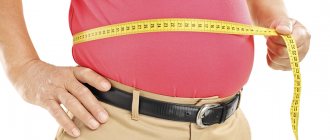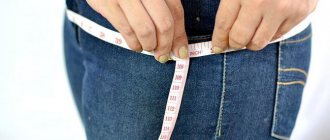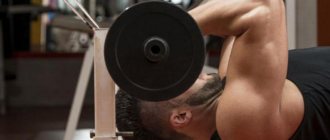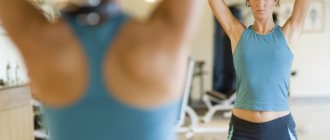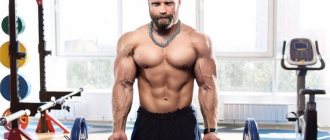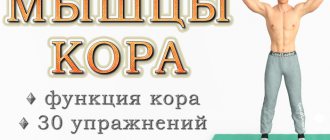Stretching is the first solution to the problem
Stretching is the first answer to the question: “How to remove calves?” Remember what people who do gymnastics or yoga look like. Slender figures with chiseled legs - all this thanks to daily muscle stretching exercises.
Before you begin stretching exercises, your muscles need to be warmed up, otherwise you could get seriously injured.
.
If you are working out at home, then to warm up you can do a light run in place or jump rope for a few minutes. If you train in the gym, then stretching is also performed after warming up the muscles, and after training it is advisable to also do a short cool-down or self-massage
to relieve muscle tension.
Place your feet shoulder-width apart and slowly lower your body. Grasp the tips of your toes with both hands and bring your head as far as you can toward your shin. Hold this position for 15 seconds. Perform 5 approaches. This exercise targets the back of the thigh and calves.
Pressing the body to the leg
Get on your knees, stretch your left leg forward, pull your foot towards you. Press your body against your extended leg as far as your muscle stretch allows. Extend your arms parallel. Hold the position for up to 15 seconds. Do the same exercise with your right leg. Perform up to 5 approaches. The hamstrings and outer calves are worked.
Lifting on your toes
Get on all fours. Without lifting your hands from the floor, lift your pelvis, standing on your toes. Without changing your posture, gradually, without sudden movements, lower yourself onto your foot. Hold this position for up to 30 seconds. Repeat the exercise up to 5 times. The calf muscle works completely.
Lunges
Stand up straight and lunge forward with your right leg. Raise your hands up. Move your body forward, stretching your arms as far as possible. Hold this position for up to 1 minute. Repeat 5 sets. The lower leg muscles and gluteal muscles are involved.
Pressing your knees to your chest
Lie on the floor, bend your right leg, clasp your knee with your hands, leaving your left leg on the floor. Extend your feet away from you and press your knee as close to your chest as possible. Hold this position for up to 1 minute. Place your hands under your right thigh and extend your leg, pulling both feet towards you. Bend your leg and extend it again with your foot facing you. Repeat up to 5 times. Repeat the same exercise for your left leg. The muscles of the back and front of the thigh and the muscles of the lower leg work.
Leg abduction
Stand up straight. Take your left leg back and up, lower your hands to the floor to maintain balance. Press your torso against your leg as far as you can. Hold this position for 15 seconds. Repeat 5 sets. The muscles of the back of the thigh and lower leg work.
After stretching, give your calf muscles a short massage to relieve tension.
Remember! Perform stretching exercises until mild pain appears, especially if you have just started exercising. Excessive muscle tension can not only lead to severe pain, but will also discourage you from continuing to reach your goal!
How to quickly pump up calves in the gym
Now that you have delved into the essence of the problem and know how to pump up your calves correctly and quickly, I would like to talk about the three simplest and most popular ways to pump up these muscle groups. I will describe them from the simplest to the most complex, and they should be performed in this order in order to avoid injuries from too sudden a load and lack of a smooth transition.
- — Exercise No. 1. Exercise equipment. Here I will not list all the types of simulators that allow you to train your calves, I will only say that a beginner should start with them. And not only because they provide an isolated load, but also for the simple reason that there is simply no other way to effectively prepare for the upcoming exercises.
- — Exercise No. 2. Smith squat. Smith machine squats are a great exercise that allows you to train your legs without worrying about putting unnecessary strain on your back and other accompanying muscles. But now the calves are important to us, and in this simulator you will stand with a barbell on your shoulders on your toes. Moreover, as I said above, the weight should be approximately equal to your own (you can lose 10-20 kilograms if your experience in the gym is less than a year).
- — Exercise No. 3. Barbell calf raises. The logical conclusion of this simple program is calf raises, but not in a machine, but with free weight. This allows you to develop auxiliary bundles of the calf muscles and give this muscle group a sharp impetus for growth, which, like nothing else, will be an excellent answer to the question of how to quickly pump up your calves.
A set of exercises at home
Not only aerobic exercise and stretching, but also various exercises for the problem muscle group will help make your calves thin.
There are many exercises for losing weight from the calves, let's look at the most common ones that can be performed both at home and on the street.
Jumping rope is the easiest type of exercise to perform that involves the calf muscles. When jumping, keep your back straight, use only your hands, and land on your toes. Jump rope starting at 5 minutes, progressing to a 30-minute workout.
Jump rope, landing on your toes, not your entire foot! This way, you soften the impact force upon contact with the floor. Jumping rope has contraindications, consult your doctor before starting exercise.
Alternating rise on toes
Place your feet wider than your shoulders, bend your knees, and point your toes out. Rise onto your toes alternately, first with your right foot, then with your left. Repeat up to 20 approaches. Internal calf muscles are involved.
Pistol
Stand straight, bend your left leg at the knee, use your hands to help maintain balance. Rise up onto the toe of your right foot and lower onto your foot. Repeat until your muscles are tired at a fast pace. Repeat up to 20 approaches. Do the same exercise with your left leg. The lower leg muscle group works.
Calf raise #1
Stand straight, feet shoulder-width apart, hands on your waist, feet apart. Rise onto your toes and lower onto your feet at maximum speed until your muscles fatigue. Perform up to 20 repetitions. This exercise works the inner side of the shin.
Calf raise #2
The starting position is the same as in the previous exercise, but turn your feet inward. Rise onto your toes and lower onto your feet at a fast pace until your muscles fail. Perform up to 20 repetitions. This exercise works the outer calves.
In addition to the above exercises, step aerobics is a good element for losing weight not only in the lower leg, but also in the entire body.
The video shows the basic elements of step, which can easily be performed at home:
How to pump up a girl's calves Training program
The calf muscles are one of those muscle groups that few people exercise separately. But in vain. After all, the beautiful appearance of legs begins with these muscles, since this part of the legs of girls can be open both in winter and in summer. In this article we will look at the correct method of training calves for women.
Features of calf muscle training for girls
Unlike men, girls do not need impressive amounts of muscle mass, as well as excessive muscle hypertrophy. This is why calf training programs for girls will differ significantly from intensive men's programs. And the main difference here is the nature of the load.
For men's training, the goal of which is muscle growth, an intense load based on performing heavy basic exercises with a large working weight and an average number of repetitions (6-8) is considered optimal.
The most important!
For women's workouts, the goal of which is strengthening, tone and aesthetic appearance of muscles, volumetric workouts with simpler and easier exercises in a large number of repetitions (15-20) are considered optimal. This load does not lead to excessive muscle growth, but it trains them well and gives them a beautiful appearance. It is precisely this load that our program will be based on.
The best calf exercises for girls
Before building a training program for the calves, you need to select a list of optimal exercises from the total number of the best exercises for the calf muscles. We will need: 1 basic and a couple of auxiliary isolated exercises.
I chose the following:
Exercises for the gym
Leg press
This exercise uses a leg press machine. Place your feet in the machine so that only your toes are on the platform. To avoid injuring your knees, keep them slightly bent. The body and legs form a right angle.
We press the platform with our toes, the heels rise slightly. Use the platform only, no weight. Perform the exercise at high speed until the muscles fail, this will burn fat and dry out existing muscles.
The feet can be placed straight, turned inward or away from you, this changes the area of load on the calf muscles.
Take dumbbells of minimal weight, stand on any step 5-7 cm high with your toes, heels on the floor. Rise onto your toes and lower onto your heels at maximum speed, as in the previous exercise.
Below is a video with a more complete set of calf exercises suitable for the gym:
Each person has his own genetics and his own level of physical fitness, so everyone needs an individual approach to finding a set of exercises for losing weight in calves. Don't expect results in a very short time, especially in a week!
The average indicators are such that by doing stretching and the presented exercises 2-3 times a week, you can achieve the first successes after 3-4 months!
The best cardio exercise for perfect legs
How to remove pumped up calves on girls’ legs? That's right, add cardio exercise, because this is a great way to burn a lot of calories, speed up your metabolism and reduce your fat percentage.
- Jumping. A great way to reduce bulging calves in girls. Moreover, this is a wonderful exercise for toning the whole body. It can be performed continuously in 2-3 sets of 2-3 minutes with a short rest.
- Run.
An excellent option for the overall health of the whole body, because absolutely all muscles will be involved. - Swimming. It gives a good fat burning effect, but the pace should be quite high.
Exercises for losing weight over pumped calves
Any girl wants to have a toned, beautiful figure, and very often it turns out that along with “pumping up” the necessary area, other, unwanted parts of the body also gain growth. For girls with large muscle volume in the calf muscle, intense strength training aimed primarily at the legs should be avoided.
Any elevation in the training complex, step aerobics and even wearing shoes with heels can lead to even greater enlargement of the lower leg. Avoid protein foods as much as possible, since protein is the main building element of muscle.
In addition to stretching exercises
Given above, there are several exercises that will help reduce over-pumped calf muscles.
The most effective way is jogging on a flat surface over long distances. With this type of running, the so-called slow muscle fibers, which have a low contraction frequency, work. They have weak growth under prolonged loads.
When running, lower your leg onto your entire foot, do not run on your toes! So, you can damage the ligaments and tendons of the foot.
Elliptical trainer
This is an effective cardio machine that simulates running. Program the machine for minimum resistance and maximum execution time. Exercises on the elliptical for 30 minutes at least 4 times a week will bring the desired result.
This is a great workout for all muscle groups. Regular swimming will not only keep you in shape, but will also improve blood circulation in all parts of the body and help you lose weight in the right areas.
Exercise bike
An important element in your training is exercise on exercise bikes and cycling. Choose to ride on a flat surface, without weights. A light bike ride will not only lift your mood and improve your well-being, but will also help you acquire slender legs.
The most important rule in the problem of getting rid of large calves is compliance with all stages of the program:
- Start your workout by warming up your muscles;
- Move on to stretching and then a small set of exercises;
- Finish your workout with self-massage of the calf muscle.
In addition to a set of exercises and exceptions for professional training, an important rule for reducing the size of the calf muscles is a balanced diet
, add more fruits and vegetables to your diet, give up fatty and floury foods. Diet combined with exercise is a surefire way to make your calves thinner.
Whatever calves you have - thick or thin, remember that every girl is unique in her own way and that part of the body that you consider problematic may actually be your advantage!
If you have large, thick, or disproportionately large calves, know that the situation can be corrected. It is almost impossible to reduce a single body part, but you can make your calves thinner if you lose weight. The exercises will strengthen the muscles in your calves. If you have a lot of fat, losing weight may help, but if your calves are made up of muscle, achieving shapely calves will be difficult. Eating right can help you become slimmer, which can affect the appearance of your calves. Additionally, your calves may become large due to certain habits. To correct the situation, you need to understand what you are doing wrong.
Precautions everyone needs to know
Beautiful legs are good, but it’s better when they are healthy. That is why now we will talk about all the precautions:
- Monitor your equipment carefully. If you feel that something is not working out for you, then it is better to replace this exercise to avoid injury.
- Any pain is a reason to stop or be extra careful.
- Headache and nausea are a reason to take a short break.
- Be sure to drink enough water.
- Remember that you should only exercise in well-ventilated areas.
- Monitor the load carefully. Firstly, pumped-up calves on girls do not look very aesthetically pleasing. Secondly, with high loads the risk of injury increases.
Steps
Selection of exercises
Types of cardio exercises Long walking on a flat surface
.
Walking is the least effective form of cardio exercise, but walking is suitable for beginners, overweight people and those recovering from injury. This is a low-intensity type of cardio exercise. Fast run.
Running burns more calories, but is harder on your joints and bones.
Swimming.
Swimming is an excellent high-intensity exercise with minimal risk of injury.
A ride on the bicycle.
This is a high-intensity load, but it does not have a serious impact on the bones and joints.
The bike is suitable for people of almost any skill level. Exercises on an ellipsoid.
The elliptical is an alternative to running because the machine simulates the movements of running but puts less stress on the joints.
To make your calves thinner, do strength exercises.
If your calves lack definition, strength training will help you lose weight overall. Muscle needs more calories than fat.
Strength training with light weights
They will help you build muscle mass and lose excess weight without increasing in volume. If you already have sculpted calves, these exercises will not help solve the problem.
Squat.
Use your own weight in the exercises.
Place your feet shoulder-width apart, place your hands on your waist, and bend your knees.
This exercise will help you strengthen your calf and thigh muscles. To make the exercise more challenging, try placing your weight on your toes rather than your heels. This will burn more calories and put less strain on your calves. Stay in the down position for 2-3 seconds and straighten up. Perform 10–15 repetitions per set.
- If you squat with a weight in your hands, your calves may increase in size.
- To make it easier to maintain balance, stretch your arms out in front of you, palms down, parallel to the floor.
- Combined with other exercises, squats can help you burn more calories and fat and strengthen your muscles.
- Rise up on your toes.
Place your feet shoulder-width apart and grab a chair or table with your hand. Rise up onto your toes, lift your heels off the ground. Hold for a second and return to the starting position. You will feel tension in your calves. Perform 20 repetitions in one approach.
Kick an imaginary ball with your feet.
Stand in front of a step the height of a ball, place your hands on your waist and throw one leg forward so that your toes touch the step (or an imaginary ball). The second leg should stand behind you at a foot's distance. Then switch legs. Repeat the movements quickly and without stopping. You will feel a burning sensation in your calf muscles.
Avoid exercises that place more stress on your calves.
If you have muscular calves,
stress on them can make them even more massive.
Avoid exercises that cause a burning sensation in your calf muscles, as this indicates a heavy load. Avoid the following exercises:
Exercises with a heavy load on the calves Climbing uphill by running or walking.
Although walking and running put stress on your calves, you shouldn't avoid them completely, but try not to walk or run uphill.
Climbing stairs or rock climbing.
Avoid step training, stair climbing and rock climbing.
Jumping rope.
Jumping jacks are a great cardio exercise, but they can also make your calves grow.
Calf raise.
This exercise will increase the size of your calves if you already have muscular ones.
Sprint.
Sprinters run on their toes, which puts a lot of stress on their calves.Proper nutrition
- Count your calories.
- You can use fitness apps (MyFitnessPal, MyPlate Tracker (in English)).
It is impossible to lose weight in specific areas, but you can lose weight in general, which will also reduce the coverage of your shins. To lose weight you should
expend more calories than you consume
To do this, you need to understand how many calories you burn and how much exercise you do.
Daily calorie intake depends on gender, age, level of physical activity and other factors. Talk to a nutritionist and ask him to create a meal plan for you.
- Eat at least 1200 calories per day.
Eat low fat foods.
If you have excess fat in your calves and need to lose weight, you may not be able to eat a diet that will target your calves first, but you can eat less fat to lose weight overall. Choose
healthy fats: avocado, nuts, olive oil.
Eating a diet rich in fruit will ensure your body gets all the vitamins, minerals and fiber it needs. All fruits and vegetables will do, but the healthiest ones will be:
Whole grains are a source of fiber, which helps you feel full faster. Thanks to this, you will eat less often. Processed grains cause wild swings in your blood sugar levels, which can make you feel hungry and tired often.
- Whole grain cereals include wheat bread, oatmeal, brown rice, whole grain pasta and barley.
Processed grains include white bread, white rice, regular pasta, and most crackers and baked goods.
Protein plays an important role in any diet. It fills you up faster and gives you energy. This allows
eat less and burn more calories.
Choose lean sources of protein over fatty ones (skip pork ribs and fatty steaks). Eat more:
- lean meat (chicken, turkey, lean beef);
legumes (peas, beans, lentils);
Lifestyle changes
- Try to always keep your weight on your whole foot.
You may be putting a lot of stress on your calves while walking.
For example, you put your weight on your toes rather than on your heel and
toes.- You may not even notice how you walk. Ask a friend to observe your walk and give you an honest opinion.
Try curling your fingers a little while playing sports. For example, if you're doing squats, lift your toes off the ground and put your weight in your heels.
- Bend towards the toes.
Sit down, bring your legs together and carefully lean forward, trying to reach your toes with your hands. Bend over until you feel discomfort and burning in your calves. Hold for 15 seconds.
Stretching with wide feet.
Place one foot in front of you, the other behind you at a comfortable distance. Bend your front leg and keep your back leg off the ground. Look ahead as you stretch the back of your calf. Stay in this position for 10–15 seconds.
Stretching with a step.
Place one foot on the floor and extend the other forward so that half of your foot is on the step. Lean forward, feel the tension in the leg that is standing on the step. Hold for 15-20 seconds and repeat on the other leg.
Head down dog pose.
Lie on your stomach, place your hands shoulder-width apart, straighten your legs. Stand on your palms, push your body up, transfer your weight to your heels. The body should form an inverted "V". Hold for 25–30 seconds.- Remember that genetics play a major role in how your calves look. If you are predisposed to large calves, you will find it very difficult to reduce them.
- Walk on a treadmill.
- Ask a therapist or exercise therapist to analyze the way you walk. You may be putting too much stress on your calves when you walk, causing them to become larger. By strengthening your calf muscles, you can make your sparks look slimmer.
Anatomical structure of the lower leg
The structure of the ankle
The leg consists of several complex structures:
- Femur. One of the strongest in the human body. It is powerful enough to withstand a load of more than 450 kg.
- The tibia and fibula are connected by thin, ribbon-like ligaments, which are very easily damaged when the ankle or other part of the lower leg is fractured.
- Calf muscles. They are not very pliable for forming relief. This is due to their constant work while walking and relatively little rest to build volume compared to the biceps of the arm.
The lower leg and foot are the most complex elements of the skeleton; they contain many ligaments that, intertwined, allow you to walk at the right pace and move smoothly.
Muscles and ligaments of the leg
The tibia consists of two bone formations:
- The tibia, which is located on the lateral part of the lower leg. Its diameter is on average twice the diameter of the fibula and it appears more massive. Most of the pressure from the femur is placed on the tibia.
- The fibula is located internally relative to the tibia and serves as a support for the vertical axis of a person. It is thinner than the fibula and therefore breaks more easily.
Calf muscles:
The back surface of the lower leg consists of the triceps muscle, which, in turn, consists of two smaller ones: the gastrocnemius and the soleus. The gastrocnemius muscle is represented by two heads: lateral and medial, and the soleus muscle is represented by one head.
The anterior surface of the lower leg is represented by several muscles: tibialis anterior, extensor digitorum longus and peroneus brevis.
The muscles of the anterior surface of the lower leg are quite thin, but their participation in the total volume of the lower leg is invaluable.
Warnings
- Before starting a new training or nutrition plan, talk to your doctor. This is especially important if you have serious health problems (such as diabetes).
Those with both thin calves and fat ones try to hide their legs under long skirts or wide jeans. We hasten to assure you that this is not the best and correct clothing. And our tips will help you choose exactly those things that will visually correct leg imperfections.
First, let's consider the option with thin calves. Girls suffer from this problem quite often. Many even turn to plastic surgeons, but we recommend turning to simpler methods. Let's start with the fact that your wardrobe should have white tights of any density. Options with tight knitting or knitting with patterns are especially good. In general, any colored tights will help make your legs look fuller. And if they also have a transverse pattern, then you can safely wear mini skirts.
Socks in combination with ballet flats or loafers can and should be worn by girls with thin calves. But it is better to wear heels only with trousers. By the way, about trousers. You can easily afford skinny jeans, but either in white or with a print. Ditch the flared skirt in favor of a pencil skirt. For skirts and dresses, the ideal length is just below the knee.
Another big problem is boots that have a wide shaft. In this case, the legs look ugly, as if they are “dangling” in the boots. If you can't find shoes with a narrow top, then choose either over the knee boots or ankle boots.
To visually make full legs slimmer, you need to wear thick black tights with skirts and shorts and always black high-heeled shoes. This will make the lower leg look longer and thinner. In summer you can do without tights, but be sure to wear nude sandals.
The style of the skirt or dress is not so important, but the length is of great importance. Choose a length 5-7 cm below the knee. Shoe heels should not be thin and graceful; they will contrast with full legs and emphasize them even more. Flared trousers and straight-cut trousers are also suitable for girls with full calves. In summer you can safely wear capris and breeches.
Marlene Dietrich also said that although everyone thinks that her legs are perfectly slender, in fact it’s all about the right trousers. So, let's take an example from her and turn our shortcomings into advantages.
The standard of thin calves is imparted by models who are tall and have long calf muscles. But what should we, ordinary women, do with our curvy calves? Let's look for the answer together!
The attitude of men and women towards pumped calves
In the end, we will find out whether men like pumped-up calves on girls.
So, there is no clear answer to this question. Opinions are divided approximately in half. Some people think that pumped-up calves on girls are beautiful, others want to see a woman with thin and petite legs next to them. One thing is clear: no one likes a flabby and shapeless body. This is why everyone still needs to play sports. Activity prolongs youth, improves health and mood.
Why are they big?
There are at least three reasons for large shins:
- wide bone and developed muscles;
- accumulation of fat in the lower leg area.
- swelling due to fluid retention.
Are large calf muscles a problem?
Developed calf muscles always attract the gaze of men. Strong legs are the beauty of a woman. Remember, if the muscles are elastic, voluminous and loaded, then cellulite and sagging will never appear in this place!
The causes of large calf muscles can be the following:
- hypersthenic body type with heavy and wide bones;
- sports background - large calves are awarded in gymnastics, athletics, and ballroom dancing.
Exercise is beneficial and actually enhances femininity if done correctly. Women with hyperasthenics can easily gain muscle mass, succeed in sports and in bikini competitions, since the muscles easily respond to growth loads.
To simply keep your muscles toned and prevent fat gain, you need to do cardio exercises twice a week - running, swimming, jumping rope, and do strength training in a high-repetition mode with minimal breaks between exercises or approaches.
Leg stretching – reducing calves
How to make your calves thinner without pumping them up even more? Stretching will help, as it relaxes tight muscles and makes them more flexible and your calves thinner.
Stand facing the wall, take a step back with one leg and fix your heel on the floor. Move your body forward so that the knee of the leg in front moves towards the wall. Hold the position for 20-30 seconds, repeat with the other leg. Sit on the floor, stretch your legs forward, bending at the hips at an angle of 90 degrees. Straighten your back, moving your pelvis back, rest your hands on the floor from behind. Pull your socks towards you and hold the pose for 20-30 seconds.
Get on all fours so that your palms are under your shoulders and your knees are under your pelvic bones.
Place your fingertips on the floor and lift your pelvis, straightening your legs and back into an inverted V position, trying to relax your lower back and tuck your stomach. Try to touch your heels to the floor to stretch your calves, hold the position for 20-30 seconds.
Do the exercises every day, or be sure to add stretching to the complex after training.
Burning fat in the lower leg area
Fat does not spare even the most working muscle - the calf. People who lead a sedentary lifestyle notice that their shins eventually turn into quivering jelly when walking.
In fact, even just flabby calves look swollen and shapeless, so they need a lift - a muscle corset.
To fight fat you need double work:
- strengthen the lower leg muscles;
- burn fat layer.
The complex should combine strength and aerobic exercises. To strengthen the lower leg muscles, calf raises with and without dumbbells are ideal. The number of repetitions can reach up to 100 times per set - calves love a lot of work!
To burn fat, you need to do aerobic exercise.
Thin calves will require any kind of jumping. Stand up straight, lower your arms at your sides, jump with your legs to the sides and at the same time clasp your arms above your head. Repeat for 30-60 seconds, move on to another exercise.
Lunge back and kick forward. Stand up straight, take a step back, squat so that your front knee forms a 90-degree angle with the floor, rise and move your back leg forward to strike, extending your toe. Repeat 10 times on each leg. Jumping from side to side. Stabilizing muscles are activated. You can jump with both feet at the same time or jump from foot to foot, which is suitable for beginners.
Bends on one leg will provide stress and stretch to the back of your legs, which will tighten loose skin. Stand on one leg, carefully bend down, moving the other leg back. For beginners, you can bend your knee. Repeat 10 times for each leg.
You can complete the complex with a minute of running in place: 30 seconds to raise your knees as high as possible, and the other 30 seconds to throw your heels towards your buttocks.
Muscle training will tighten your legs and help create protection against the accumulation of excess fat. Typically, thick calves are the tip of the iceberg and are actually the last to gain weight.
Look at your thighs, belly and back of your arms - there is no doubt that there is flab on them too if it has affected the lower leg.
The remedy against it is training in the gym, but do not run to the machines, choose dumbbells and barbells to make the muscles work naturally.
How to thin calves with swelling?
Eliminate the cause of swelling. Of course, if your legs are swollen due to diseases of the kidneys, heart and liver, then the direct road to the doctor. You should not try to take diuretics on your own; perhaps the problem lies much deeper.
If swelling appears after prolonged standing, running, or walking, then simply raise your legs up to ensure blood flow. Give your feet and ankles a good rest, choose comfortable shoes for walking, and avoid heels.
Civilization not only gave man benefits, but also added a number of problems. Among them, oddly enough, are improperly formed leg muscles, especially the calves. What does civilization have to do with it, you ask? And despite the fact that we began to walk much less.
Public transport and personal cars have taken away from us the treasured 10,000 steps a day, which we so need for beauty and health. The result is weak and unaesthetic calf muscles, with complexes about this in addition.
More and more girls can boast of frail cellulite sticks instead of beautiful female legs. And we won’t say anything about men at all: chicken legs sticking out of shorts look even more disgusting, especially if a carcass of impressive dimensions rises above them.
Even boys now prefer virtual football to real football and wait in the morning, shifting at the door from one thin leg to another, for their parent to drop them off at school, instead of walking five hundred meters. However, the problem of thin calves can be solved, like many things in our lives. And you can solve it without leaving your home. You just need a little patience and time.
How to reduce the calf muscles on your legs
If you want to have beautiful and attractive legs, but there is sorely not enough time to pump up your calves, you can still lose weight by doing simple exercises at any convenient and free time. For example, you need to stop using the elevator at the entrance, walk more, and try to hold the load equally in both hands.
To quickly reduce the calf muscles on your legs and noticeably lose weight, you need to choose a small rise (in the gym this is a step platform, at home - a step, a curb). Stand with your feet halfway up so that your heels hang down. Rise up and down, gradually increase the pace, maintain balance as an additional load.
These can be classic squats with a straight back or lunges alternately with both limbs, which are aimed at intensively working the calves. The duration of the approaches and their intensity (depth of the squat) is determined individually and depends entirely on the physical health of the woman losing weight and the desire to lose weight quickly.
Useful exercises
In our article we will focus on those exercises that can be performed at home. It is worth noting that most often they are performed without additional weight. If you find them too easy to do, you can pick up a couple of five-liter water bottles or other heavy objects.
Girls should pay attention to the legs of dancers and gymnasts. It is in their legs that they have everything and there is nothing superfluous.
Rhythmic gymnasts, for example, do not use any additional sports equipment during training at all, using only their body weight, including pumping up their calves.
To do this, their daily training arsenal contains exercises that are remarkably effective.
| Springs |
|
| Stand lifts | A step platform, a thick encyclopedia, or just a step will be needed for the next exercise. Stand with your toes on the step, leaving your heels in the air. Now rise “on tiptoes” and then lower down, stretching your ankle to the limit, touching your heels to the floor. On a step or step platform, you have the opportunity to maneuver: you can adjust the angle of rotation of the foot and work exactly the part of the calf that is needed. Girls often need to pump up the inside of their calves. If you keep your feet parallel when performing insteps, then the middle part of the muscles will receive more load; if the heels are together and the toes apart, then the inner part will work more, but vice versa - the heels apart, the toes together - load the outer part of the calf muscles. Men's platform lift: Lift up with maximum range of motion while holding a dumbbell in one hand and using the other hand against a wall for balance. |
| Walking on toes | The simplest and most accessible exercise everywhere: walking on your toes, like a ballerina. Rise high on your tiptoes and walk in small steps, almost without bending your knees. |
| Walking up the stairs | A great way to pump up your calves, this time without leaving your front door. Find out at what time the movement of residents in your entrance subsides and go ahead! Up and down the stairs. You can do it over a step and with dumbbells. 15-30 minutes will be enough. |
| Jumping rope | Everything is clear here. If your living space allows, take a jump rope and jump until your calves burn. This is an exercise from the arsenal of gymnasts and boxers. |
| Jumping with a load | Jump up from a squat while holding dumbbells in your hands. This is another exercise that puts a serious strain on your calves. |
| Squats with a load | There are dumbbells or a six-liter canister of water in your hands, and a burning sensation in your legs from repeated repetitions of the same action: squats. |
| Seated calf raises | It is imperative to pump up your calves while sitting, because this is the only way to pump up the soleus muscle, hidden from view, which gives three-quarters of the volume to the calves. Exercises done while standing put stress on the outer calf muscle, but this is only a quarter of the volume. Sit on a chair, grab a can of water, or sit your child on your lap. Raise your feet on your toes. If after 15 repetitions your shins “burn”, then you took the right weight. The exercise is performed slowly. |
| Gun | Remember this exercise from physical education lessons at school? Surely you remember. True, it is difficult to do, so it is suitable for advanced athletes. Hold onto something with your hand and, with one leg extended forward, squat down on the other as many times as you can. |
| Run | Jogging (how to breathe properly when running) will help pump up your calves very quickly. Do not neglect this method, especially in good weather. |
| Bicycle, skis, tennis, roller skates | Any of the above sports is “calf-forming” and gives amazing results for the leg muscles. So buy roller skates or a racket and pump up the muscles you need while enjoying a fun, non-boring sport. True, this time you won’t be able to sit at home. |
Choose 4-5 exercises you like and perform them every 3-4 days. You can alternate them and change places so that the muscles do not get used to the load.
- Before doing a set of exercises to develop your calves, be sure to stretch the joints of your ankles and fingers and warm up the muscles themselves.
- After exercise, be sure to stretch your calf muscles. To do this, take a wide step back, placing your heel on the floor and leaning your body forward. Stretch for 10-20 seconds with each leg.
- The range of motion when performing exercises should be maximum.
- The load needs to be changed. Vary the exercises and load, otherwise addiction will occur, which will reduce the effect of the exercises.
- You need to train your calves two or three times a week, giving the muscles time to recover.
- Aerobics should be done at the beginning of the workout, and strength training on the calves should be completed. This is the only way to achieve calf growth.
- If you transfer weight to your thumbs when lifting, the load on the muscles will be better.
- To further complicate the exercises and pump up men's calves, hold for five counts at the top of the lift.
- When pumping up your calves, the main thing is not to overdo it and not overwork the muscles, otherwise you can bring yourself to cramps. And this is at least unpleasant.
